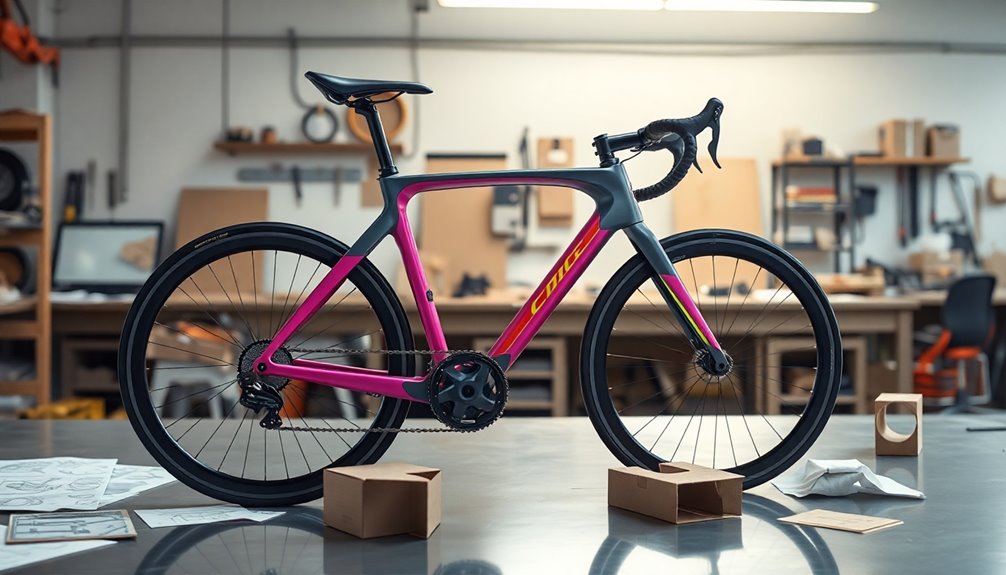If you're curious about how bicycle innovations are reshaping transportation, you'll find the cardboard bicycle fascinating. Designed from recycled cardboard, it's affordable, lightweight, and supports high weight capacities, making cycling accessible for everyone. Traditional materials and advanced designs are also evolving, focusing on sustainability. As consumer demands grow, new models like e-bikes are gaining popularity. Discover the trends and challenges in modern cycling that push these innovations forward and open up new possibilities.
Key Takeaways
- The cardboard bicycle utilizes innovative Japanese origami techniques to enhance strength and waterproof properties, revolutionizing bicycle design and materials.
- With a low production cost of approximately $9, the cardboard bike promotes affordable mobility solutions for low-income consumers and children.
- Advances in materials, including recyclable thermoset composites, are driving the production of eco-friendly bicycles focused on sustainability and reduced maintenance.
- Urban mobility solutions are evolving, with a growing demand for lightweight designs and electric bike conversion kits transforming traditional bicycle usage.
- Community engagement is crucial for promoting cycling accessibility, with initiatives like bike-sharing programs enhancing local transportation networks and encouraging healthier lifestyles.
The Vision Behind the Cardboard Bicycle
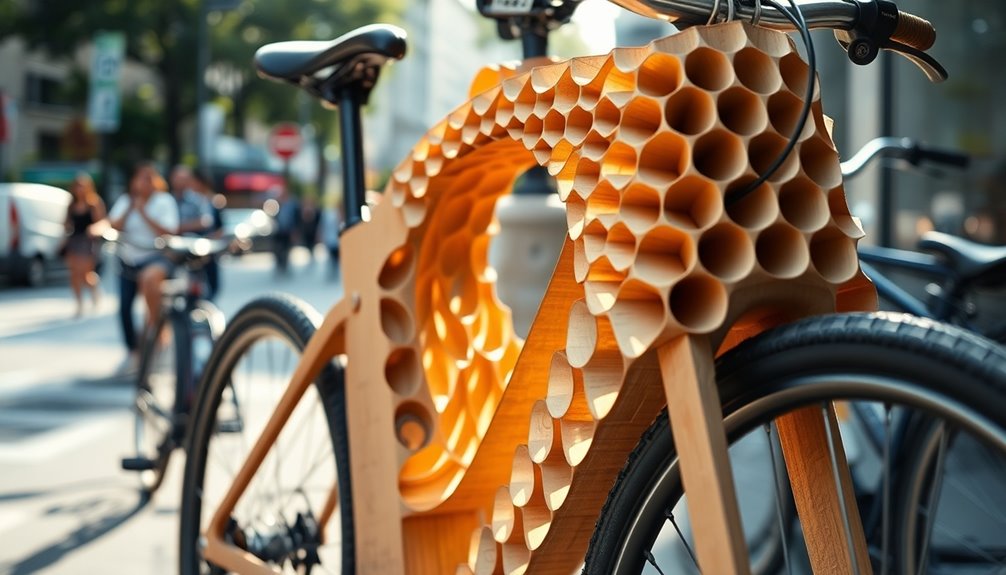
The cardboard bicycle, a groundbreaking invention by Izhar Gafni, showcases how innovation can address pressing social issues.
Inspired by the strength of a canoe made from recycled cardboard, Gafni spent three years developing the cardboard bike, utilizing Japanese origami techniques to enhance its durability. This design allows the bike to support riders up to 435 lbs, making it accessible to a wider audience.
With a production cost of around $9, Gafni aims to retail it between $60-90, targeting low-income consumers and children in developing countries. His vision emphasizes sustainability and promotes cycling as an eco-friendly transportation option, reminiscent of Henry Ford's impact on car accessibility.
The cardboard bike represents a significant step toward improving mobility for underserved communities.
Materials Matter: The Evolution of Bicycle Manufacturing
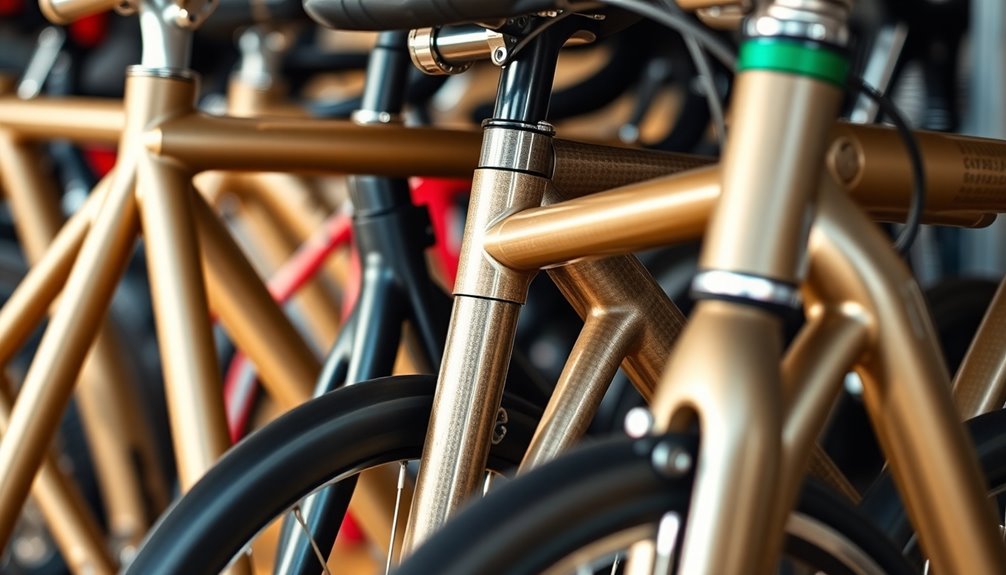
Innovations like the cardboard bicycle by Izhar Gafni highlight how materials play an essential role in shaping the future of cycling. Made almost entirely from recycled materials, this bike boasts production costs between $9 and $12, illustrating a low-cost manufacturing approach.
Innovative cardboard bicycles showcase the potential of recycled materials for affordable and sustainable cycling solutions.
Techniques inspired by Japanese origami enhance the cardboard's strength and waterproof properties, making it more durable than traditional materials.
Meanwhile, modern bicycle manufacturing increasingly utilizes recyclable thermoset composites, promoting closed-loop recycling. Advances such as hot melt prepregs and carbon fiber belt drives aim to enhance performance and reduce maintenance for e-bikes.
As consumers demand lightweight, eco-friendly options, manufacturers focus on innovative designs that prioritize both functionality and sustainability in urban mobility solutions.
The Role of Sustainability in Modern Cycling
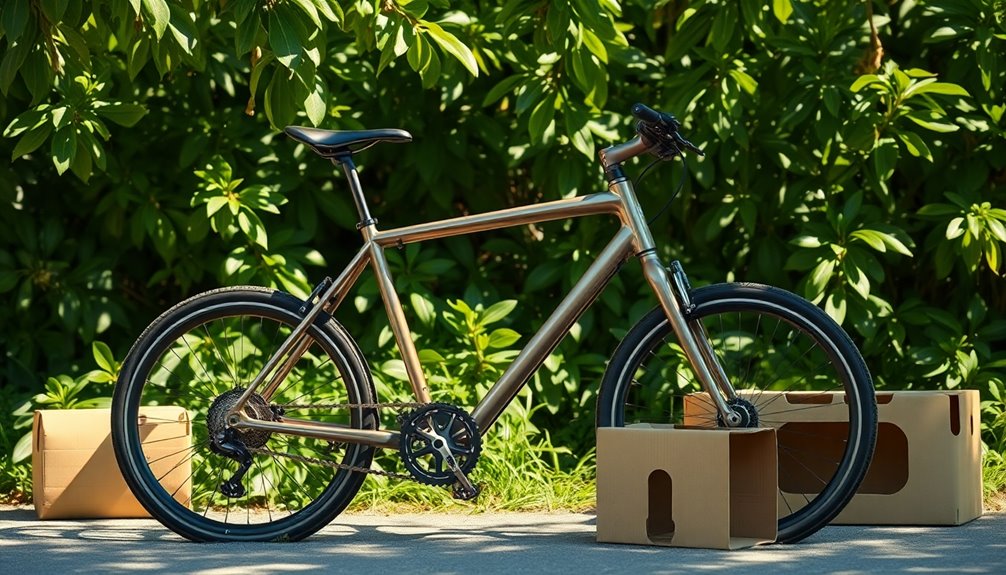
While many view cycling merely as a mode of transportation, it's quickly becoming a symbol of sustainability in our modern world.
The cardboard bicycle, developed by Izhar Gafni, showcases how recycled materials can revolutionize manufacturing practices. With a production cost of only $9, this bike makes sustainable transportation accessible, particularly for children in developing countries.
Innovations in recyclable materials, like thermoset composites, are further driving eco-friendly bike production, cutting down carbon emissions and waste.
By embracing cycling, you contribute to reducing oil dependence and promoting healthier lifestyles. Cardboard bikes also encourage community resource sharing, enhancing well-being through local bike-sharing programs. Additionally, hybrid bikes' versatility allows for efficient commuting while maintaining a commitment to eco-friendly practices.
Ultimately, cycling embodies a commitment to sustainable living that benefits both individuals and the planet.
Innovative Designs Shaping the Future of Bikes

- Cardboard bike supports riders up to 435 lbs, costing only around $6 to produce.
- E-bikes like the BER and Intelectra focus on lightweight designs for urban mobility.
- Advanced materials, such as recyclable thermoset composites, enhance sustainability.
- The cardboard bike aims to serve low-income communities and children in developing nations.
- These designs shift our perspective on what a bike can be, blending functionality with eco-friendliness.
- Similar to Hyundai tuning options, innovative designs in cycling enhance performance and accessibility for a broader range of riders.
Market Trends: What Consumers Want in Bicycles
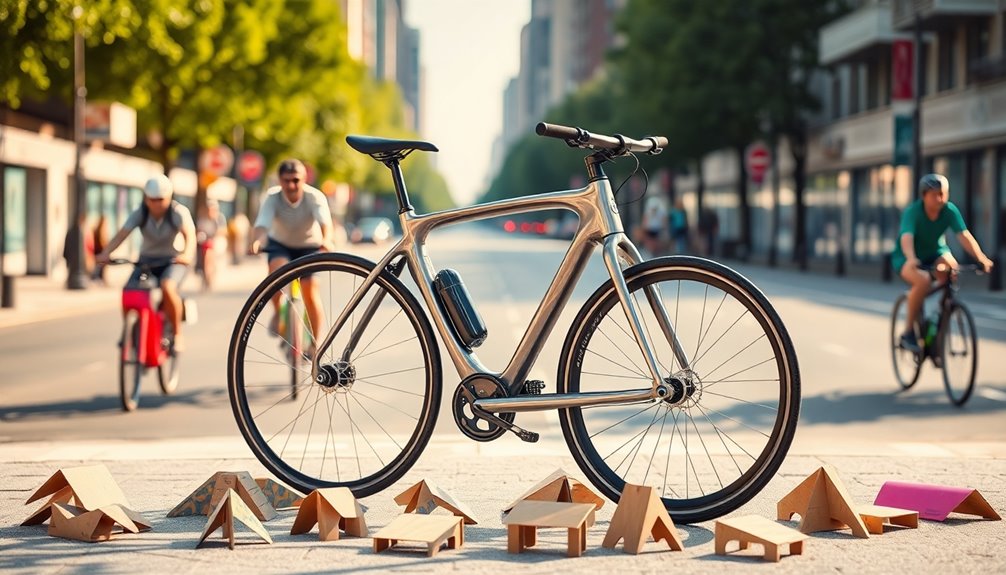
As you explore the latest bike trends, you'll notice a strong shift towards lightweight designs and sustainable materials.
Many riders now want bicycles that aren't only easy to carry but also environmentally friendly.
Additionally, urban mobility solutions are becoming essential, ensuring you can navigate city streets with ease while reducing your carbon footprint. Furthermore, the rise of electric bike conversion kits is transforming traditional bicycles into high-performance machines that cater to these modern demands.
Sustainable Materials Preference
With the growing awareness of environmental issues, consumers are now prioritizing sustainable materials in bicycle design more than ever.
You want bikes that not only perform well but also contribute to a healthier planet. Manufacturers are responding by incorporating innovative materials, including recycled cardboard and thermoset composites.
Here are some trends you're likely to see:
- Use of recycled materials to reduce waste
- Lightweight designs made from eco-friendly composites
- E-cargo bikes featuring sustainable components for urban mobility
- Long-lasting materials that enhance durability and performance
- Techniques aimed at minimizing carbon emissions during production
Lightweight Design Demand
Consumers are increasingly looking for bicycles that not only feature sustainable materials but also prioritize lightweight designs. You want bikes that are easy to handle and portable, especially if you're commuting in an urban environment.
E-bikes like the BER, weighing under 15.98 kg, are particularly appealing for this reason. Manufacturers are responding by adopting innovations like recyclable thermoset composites and lightweight aluminum frames to enhance performance while reducing carbon emissions.
In the e-cargo bike market, you'll find designs that maintain high payload capabilities without the cumbersome weight. As a result, consumers like you're willing to invest in bicycles that blend lightweight design with functionality, proving that practicality is key in today's cycling trends, just like packing a bike in a cardboard box for transport.
Urban Mobility Solutions
In urban settings, the demand for practical mobility solutions drives innovation in bicycle design. Over the past three years, you've likely noticed a shift towards lightweight, eco-friendly options. E-bikes like the BER, weighing under 15.98 kg, exemplify this trend. Consumers want bikes that are both functional and sustainable, prompting manufacturers to rethink their approaches.
- Increased focus on e-cargo bikes for better logistics
- Emphasis on reducing carbon emissions during production
- Partnerships for improved cycling infrastructure
- Engaging community discussions to promote cycling
- Innovative designs catering to urban commuting needs
These trends show that as cities evolve, so do your mobility choices, making cycling more accessible and appealing than ever. Additionally, incorporating diversification strategies in urban mobility options enhances overall sustainability and user experience.
Challenges in Bicycle Production and Innovation

When you think about bicycle production, two major challenges stand out: scaling production and ensuring material durability.
You might wonder how manufacturers can meet the demand while maintaining the strength and longevity of new materials.
Addressing these issues is essential for the future of innovative bicycle designs.
Production Scaling Issues
Scaling production for innovative bicycles, like the cardboard model created by Izhar Gafni, presents several challenges that manufacturers must navigate. They need to guarantee that the bike frame remains durable while keeping production costs low, typically between $9-$12.
Additionally, companies face hurdles related to market acceptance and the reliability of their products.
- Balancing innovation with cost-efficiency
- Addressing consumer demands for sustainable options
- Collaborating within the industry for improved infrastructure
- Overcoming perceptions about alternative materials
- Maintaining quality during mass production
Continuous evolution is critical in this rapidly growing market, as manufacturers aim to meet eco-friendly design preferences while enhancing their production capabilities amidst these scaling challenges.
Material Durability Concerns
Manufacturers must address serious material durability concerns as they scale production of innovative bicycles. Engineers have been skeptical about using cardboard due to its structural integrity under stress, especially in environments like New York's unpredictable weather.
To guarantee safety, the cardboard bicycle requires rigorous testing against water and humidity while maintaining strength. Balancing low production costs of $9-$12 with quality standards is challenging, yet fundamental for consumer acceptance.
The design, inspired by Japanese origami techniques, aims to enhance cardboard's durability, but ongoing research is critical to overcome material limitations. Market acceptance remains a hurdle, as many consumers hesitate to embrace non-traditional materials for their transportation needs.
Addressing these concerns is essential for the success of cardboard bicycles.
The Impact of Community and Accessibility on Cycling Solutions

While many cities endeavor to promote cycling as a sustainable mode of transportation, the true potential of these efforts often hinges on community involvement and accessibility.
The cardboard bicycle, designed by Izhar Gafni, exemplifies this by providing affordable options for low-income individuals, especially children. Its lightweight, eco-friendly design supports substantial weight while improving access to education and resources.
- Promotes cycling as an eco-friendly alternative
- Enhances local transportation networks through bike-sharing
- Provides affordable transportation solutions for underserved communities
- Encourages community resource sharing and connectivity
- Addresses both transportation and accessibility challenges
When communities engage in these initiatives, you'll see a positive shift in health, well-being, and educational opportunities, making cycling a viable choice for more people.
Frequently Asked Questions
How Much Is the Cardboard Bike?
The cardboard bike's expected retail price ranges from $60 to $90, making it an affordable option for many.
With a production cost of around $6 for the adult version and about $3 for the kids' model, it's designed to be accessible, especially for low-income individuals.
Which Company Created a Bike Made Almost Entirely From Recycled Cardboard?
Imagine a world where bicycles are born from the earth's remnants, just like a phoenix rising from ashes.
That's where Izhar Gafni comes in, creating a bike made almost entirely from recycled cardboard. His inventive spirit transforms discarded materials into something functional and sustainable.
This bike not only champions eco-friendliness but also offers affordability, making cycling accessible to everyone.
What Is Considered One of the Most Important Innovations of the Bicycle?
One of the most important innovations in bicycle design is the introduction of lightweight materials like carbon fiber.
You'll notice that these materials not only enhance performance but also contribute to sustainability.
Additionally, the development of the derailleur system transformed how you shift gears, making your ride smoother on different terrains.
These advancements, combined with features like electric motors and improved braking systems, have greatly changed the cycling experience for riders today.
Are Cardboard Bike Boxes Safe?
Think of cardboard bike boxes as a sturdy cocoon, cradling your bicycle during its journey.
Yes, cardboard bike boxes are safe! They're crafted from double-walled cardboard, providing solid protection against impacts.
Plus, their lightweight nature helps cut shipping costs. Many boxes include waterproof and fireproof coatings, enhancing durability.
With reinforced corners and edges, they withstand handling stresses, proving that, when designed properly, cardboard can be just as protective as traditional materials.
Conclusion
As you explore the world of bicycle innovations, consider this: could the next big breakthrough come from materials that seem unconventional, like cardboard? It's fascinating to think about how sustainability and creativity can reshape our cycling experience. By embracing new designs and responding to consumer desires, the future of biking looks brighter than ever. So, what's your take—are these innovations just trends, or could they genuinely revolutionize how we ride? The answer might surprise you!
